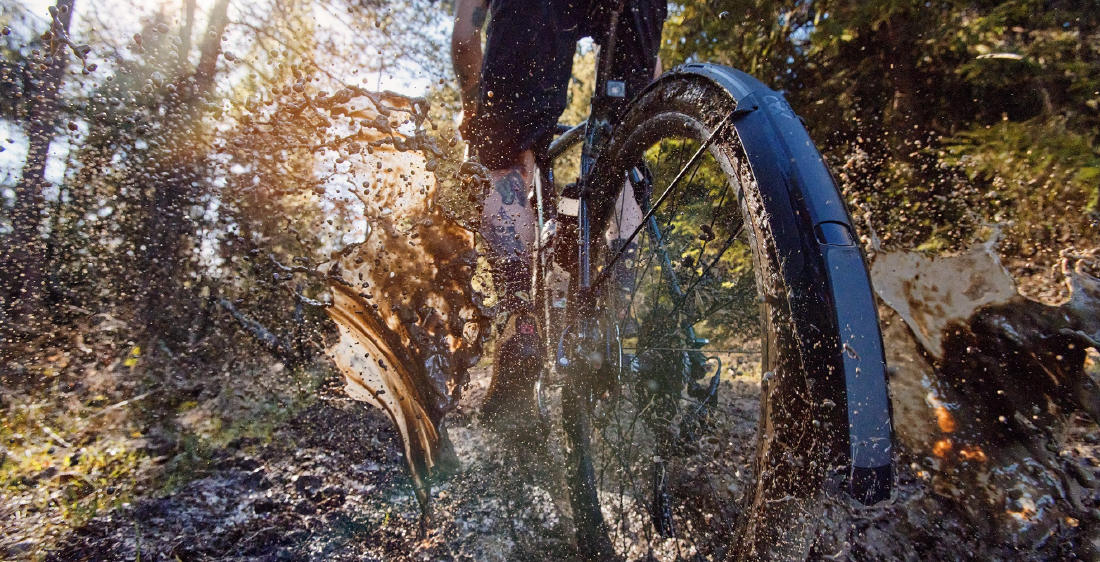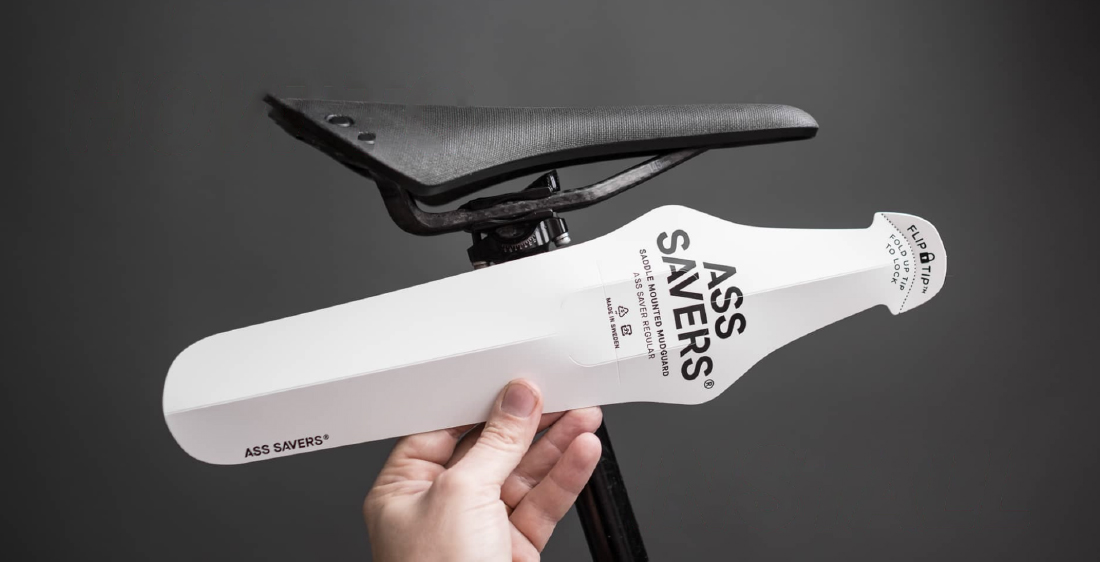
A guide to choosing bike mudguards?
If you are looking to ride through the seasons, a set of mudguards is an essential accessory for your bike. It will help keep you and your clothes dry and protect your bike frame and components from grit and mud. In this guide, we will explain the differences between the types of mudguards and help you determine which is the best option for you.
What is a mudguard?
A mudguard (or fender if you live in America) is a curved piece of metal or plastic which is placed above your tyres to protect you from mud, water and other projectiles in wet conditions.
What is the use of a mudguard?
The primary use of a mudguard is to help keep you dry by preventing wet projectiles from reaching your back, legs and arms. However, fenders also protect your frame and components, meaning less to clean after a ride and fewer parts to replace after a wet winter season.
In group rides, mudguards are also a must, as they protect other cyclists in the group from direct sprays coming from your rear wheel. Most road cycling clubs will require that you fit your bike with mudguards during the winter months to participate in group rides.
How do I choose a bike mudguard?
Mudguards come in 4 main types. Determining which is right for your bike depends on the required protection and your bike frame. When choosing a mudguard, you need to consider the following three things:
- Clearance: the distance between your wheels and frame
- Eyelets: some bikes come with eyelets to allow you to fit full-length mudguards, while others don't.
- Protection needs: are you a road cyclist conscious of weight, a commuter looking for the best coverage to arrive to work as clean as possible, or a minimalist looking for the bare minimum?
Mudguard Types
Full-Length Mudguards

Pros:
- Maximum wheel coverage
- Sturdy
- Excellent protection for the rider, bike and riding companions
Cons:
- Require eyelets on your bike frame and enough clearance
- Not easily removed
- Heavier than other options
Full-length or traditional mudguards offer the best protection for you, your clothes, your bike and people cycling around you. However, they won't fit every bicycle.
Their long design ensures they catch a large amount of the spray thrown up by your wheels. Some, like the SKS Raceblade Pro Stealth Series Mudguards come with mudflaps to give additional spray protection. Made of aluminium, plastic or a combination of both, they tend to be less aesthetically pleasing than other mudguards.
Traditional mudguards will often come as standard on hybrid, commuter and city bikes, where weight and aesthetics come second to comfort and practicality.
However, while they offer the maximum wheel coverage and sturdiness, they are harder to fit and take on and off easily. This lack of adaptability will not suit some riders who like to modify their bike depending on road conditions.
Another aspect to consider when choosing full-length mudguards is the presence of eyelets and sufficient clearance on your frame. Full-length mudguards are attached via the ends of their steel arms. The arms are bolted onto the bike's frame through eyelets. If your bike doesn't come with eyelets, you need to consider a different type of mudguard. You will also need sufficient clearance under the brakes and behind the seat tube to fit them.
Clip-On Mudguards
Pros:
- Versatile and easy to fit
- Good level of coverage
- Fits most frames
Cons:
- Not fixed: mudguards can end up off centred, leaving you exposed
- Not as sturdy as full-length mudguards
- Lower protection than full-length mudguards

If your bike cannot fit full-length mudguards or if you do not want to commit to a hard-to-remove fender, then clip-on mudguards are the way to go.
They are more versatile than traditional mudguards, as you can whip them off easily. From mounting brackets to cable ties and elastic bands, there are many mounting solutions offered, meaning you can adapt to the riding conditions in seconds. Most snap-on mudguards will be quickly attached and removed thanks to quick-release fittings that works on most frames, including aero-forks like the SKS S Board and S Blade Mudguards Set. These clip-on fenders are also lighter than the full-length mudguards making them more appealing to weight-conscious riders.
However, while their coverage varies, they offer less protection than traditional mudguards. They also tend to be flimsier and more prone to break.
Again, as with full-length mudguards, it is important to check your frame clearance when buying clip-on mudguards. Most manufacturers will indicate a maximum tyre size or minimum clearance to help you determine which clip-on mudguard is right for your bike.
Mountain Bike Mudguards

Pros:
- Light
- Fits most bikes
- Don't clog with mud
Cons:
- Not as much coverage
- Can end-up off-centred
- Not as sturdy
Designed for off-road bikes, MTB mudguards are popular with road riders and commuters too. These mountain bike mudguards sit high above the wheels to ensure the mudguards don't get clogged with mud as you ride off trails. They are usually wider like the SKS Mud-X and X-Tra Dry Set.
Mounted differently from the clip-on and traditional mudguards, they clip to the frame by the down tube and seat post, making them easy to attach and remove.
When buying a mountain bike mudguard, you should ensure the fitting brackets fit your seat tube diameter (most are adjustable). You should also check that the mudguard can accommodate your wheel diameter (26", 27.5" or 29"). Not all mudguard designs are universal.
Ass-Saver Mudguards
Pros:
- Extremely light
- Easy to fit and remove
- Cheap
Cons:
- Not as sturdy as any of the other mudguards
- No protection for your bike components
- No protection for your legs or front
If none of the above mudguards is right for you and you are just looking for something quick to install, versatile and budget-friendly, the ass-saver is the way to go.
These simple rear mudguards are pliable plastic piece which fits under your saddle, giving you basic protection.
Ass-savers are perfect to use as an emergency mudguard when the weather isn't bad enough yet to fit a complete winter kit.
Bike Mudguards FAQs
Are mudguards necessary?
Mudguards are an essential part of any winter cycling kit. They will protect you and your bike from the sprays of water, mud and debris coming from the wheels making cycling in wet conditions much more comfortable.
In many cycling clubs, mudguards are compulsory for wet weather riding as they stop the riders behind you from being soaked by your bike's spray. Even if you are not part of club's group rides, anyone you ride with will appreciate you using mudguards.
Do you need mudguards on a mountain bike?
While bike mudguards are not essential, using a mudguard is a cost-effective and easy way to make your winter mountain rides more comfortable and pleasant. Mudguards will help keep you dry, warm and less muddy. We suggest you try some of SKS tried and tested MTB mudguards set for yourselves: SKS X-Board front mudguard and SKS X-Tra Dry rear mudguard.
Are bike mudguards universal?
Unfortunately, no. As discussed above, depending on your bike clearance and whether your frame has eyelets, certain mudguards will fit your bike, whereas others won't. That said, clip-on mudguards and MTB ones are more versatile than full-length mudguards. Over the years, we found that the SKS Beavertail set is an extremely versatile mudguards set that fits most bikes coming through our doors.
How to install bicycle mudguards?
Installing a mudguard depends on the type of fender you are mounting to your bike.
Clip-on and MTB mudguards are easily fitted with mounting brackets and other easy-tied solutions and do not require any tools.
Full-length mudguards are installed via bolts through the eyelets on your frame.
At Eurocycles, we are happy to fit any mudguards you purchase with us free of charge.
What mudguard width do I need?
To ensure your mudguards don't impede your riding and fit your bike, the mudguards you choose need to be a little wider than your tyre. Full-length mudguards also need the correct clearance in the frame and forks.
For example, a 32c wide road tyre (32mm wide) will need a mudguard 35mm wide.




